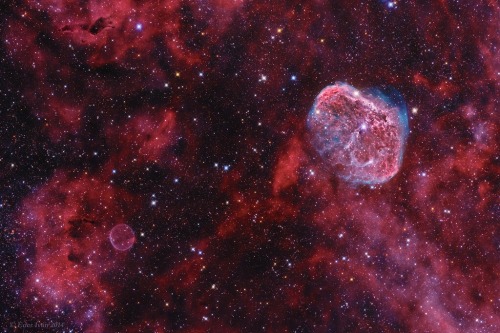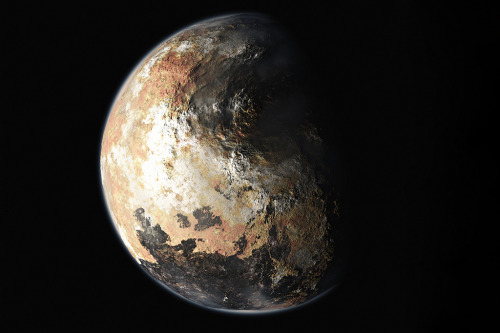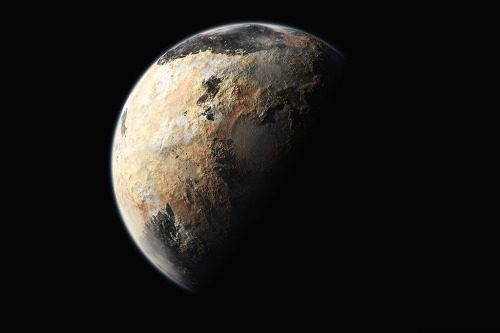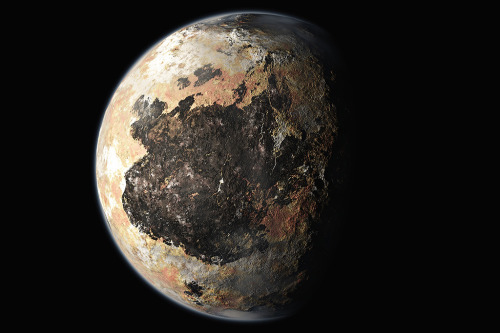“Soap Bubble With Crescent, NGC6888” By Ivan Eder On Flickr.

“Soap Bubble with Crescent, NGC6888” by Ivan Eder on Flickr.
More Posts from Littlecadet-biguniverse and Others

Charon and Pluto: Strikingly Different Worlds
js
Another Station Upgrade:
Spacewalkers Jeff Williams and Kate Rubins to install new TV cameras
On Thursday, Sept. 1, U.S. astronauts Jeff Williams and Kate Rubins will conduct the station’s 195th American spacewalk. As part of their activities, the pair will install the first of several enhanced high-definition television cameras that will monitor activities outside the station, including the comings and goings of visiting cargo and crew vehicles

Working on the station’s backbone, or truss, Williams and Rubins will retract a thermal radiator that is part of the station’s cooling system.

As was the case for their first spacewalk together on Aug. 19, Williams will be designated as extravehicular crew member 1 (EV1), wearing a spacesuit with a red stripe, while Rubins will be EV2, wearing a suit with no stripes.
Watch LIVE!
Coverage of the spacewalk begins at 6:30 a.m. EDT on Thursday, Sept. 1; with the spacewalk scheduled to begin at 8:05 a.m. EDT. Stream live online HERE.
Make sure to follow us on Tumblr for your regular dose of space: http://nasa.tumblr.com
'Enterprise' Nebulae Seen by Spitzer
NASA - Spitzer Space Telescope patch. Sept. 8, 2016
Image above: These nebulae seen by NASA’s Spitzer Space Telescope, at left, may resemble two versions of the starship Enterprise from “Star Trek,” overlaid at right. Image Credits: NASA/JPL-Caltech. Just in time for the 50th anniversary of the TV series “Star Trek,” which first aired September 8th,1966, a new infrared image from NASA’s Spitzer Space Telescope may remind fans of the historic show. Since ancient times, people have imagined familiar objects when gazing at the heavens. There are many examples of this phenomenon, known as pareidolia, including the constellations and the well-known nebulae named Ant, Stingray and Hourglass. On the right of the image, with a little scrutiny, you may see hints of the saucer and hull of the original USS Enterprise, captained by James T. Kirk, as if it were emerging from a dark nebula. To the left, its “Next Generation” successor, Jean-Luc Picard’s Enterprise-D, flies off in the opposite direction. Astronomically speaking, the region pictured in the image falls within the disk of our Milky Way galaxy and displays two regions of star formation hidden behind a haze of dust when viewed in visible light. Spitzer’s ability to peer deeper into dust clouds has revealed a myriad of stellar birthplaces like these, which are officially known only by their catalog numbers, IRAS 19340+2016 and IRAS19343+2026. Trekkies, however, may prefer using the more familiar designations NCC-1701 and NCC-1701-D. Fifty years after its inception, Star Trek still inspires fans and astronomers alike to boldly explore where no one has gone before.
Spitzer Space Telescope. Image Credits: NASA/JPL-Caltech
This image was assembled using data from Spitzer’s biggest surveys of the Milky Way, called GLIMPSE and MIPSGAL. Light with a wavelength of 3.5 microns is shown in blue, 8.0 microns in green, and 24 microns in red. The green colors highlight organic molecules in the dust clouds, illuminated by starlight. Red colors are related to thermal radiation emitted from the very hottest areas of dust. JPL manages the Spitzer Space Telescope mission for NASA’s Science Mission Directorate, Washington. Science operations are conducted at the Spitzer Science Center at Caltech in Pasadena, California. Spacecraft operations are based at Lockheed Martin Space Systems Company, Littleton, Colorado. Data are archived at the Infrared Science Archive housed at the Infrared Processing and Analysis Center at Caltech. Caltech manages JPL for NASA. For more information about Spitzer, visit: http://spitzer.caltech.edu http://www.nasa.gov/spitzer Images (mentioned), Text, Credits: NASA/Tony Greicius/JPL/Elizabeth Landau/Written by Robert Hurt, NASA’s Spitzer Science Center. Greetings, Orbiter.ch Full article
Do telescopes actually take colorful photographs or are the pretty colorful photographs of galaxies that we know colored afterwards? If a human was floating through space, would space look colorful to them?
So some pictures are taken in different wavelengths to see different characteristics. (infrared wavelengths to see through thick gas and dust, xray wavelengths to see highly energized regions)
But, in the visible wavelengths you are seeing the colors. They’re just enhanced brighter than they might be.
For example, I took this picture of “the California Nebula” using a camera (Canon 60Da) attached to a telescope. This shows one exposure, and the background is red due to effects of the camera (which you subtract):

You take multiple exposures, combine them, subtract the background effects & adjust the color a little and get this…


Three LEGO Minifigures Journey to Jupiter
Did you know that the Juno mission is also one giant leap for minifigure-kind? Three LEGO crew members have set their sights on being the first toy to visit another planet, enduring the five year, 1.75 billion mile journey aboard NASA’s Juno spacecraft. One minifigure is a likeness of Galileo Galilei – who discovered Jupiter’s four largest moons. The other two represent the Roman god Jupiter and his wife Juno. Each figure has been custom molded out of aluminum to represent their special characteristics. Jupiter carries a lightning bolt, Juno has a magnifying glass to represent her search for truth, Galileo is carrying a telescope and a model of the planet Jupiter.
To me, these minifigures add a beautifully ordinary and intensely human element to this extraordinary mission.
Explore more of the LEGO Group’s partnership with NASA at LEGO.com/Space

These three bright nebulae are often featured in telescopic tours of the constellation Sagittariusand the crowded starfields of the central Milky Way.
In fact, 18th century cosmic touristCharles Messier cataloged two of them; M8, the large nebula left of center, and colorful M20 near the bottom of the frame. The third, NGC 6559, is right of M8, separated from the larger nebula by dark dust lanes. All three are stellar nurseries about five thousand light-years or so distant. The expansive M8, over a hundred light-years across, is also known as the Lagoon Nebula. M20’s popular moniker is the Trifid.
In the composite image, narrowband data records ionized hydrogen, oxygen, and sulfur atoms radiating at visible wavelengths. The mapping of colors and range of brightness used to compose this cosmic still life were inspired by Van Gogh’s famous Sunflowers.
Just right of the Trifid one of Messier’s open star clusters,M21, is also included on the telescopic canvas.
Object Names: M8, M20, M2, NGC 6559
Image Type: Astronomical
Credit: NASA, AndrewCampbell
Time And Space

The Spider and the Fly - IC 417
NASA’s Spitzer Space Telescope floats ~93 million miles from earth as it silently observes our universe. In this image we see the nebula IC 417, located in the constellation Auriga, about 10,000 light-years away. Star formation is occurring rapidly in this nebula.
“A cluster of young stars called “Stock 8” can be seen at the top. The light from this cluster carves out a bowl in the nearby dust clouds, seen here as green fluff. Along the sinuous tail in the center and to the bottom, groupings of red point sources are also young stars.”
Credit: NASA/JPL

Herschel’s Eagle Nebula, some 6,500 light-years away.
Image Credit & Copyright: ESA/Herschel/PACS, SPIRE/Hi-GAL Project


Mercury is passing directly across the sun for the first time in nearly a decade.
The innermost planet of our solar system will look like a small, dark circle cutting across the sun’s disc. In the U.S., the transit began shortly after 7 a.m. ET on Monday and will continue for more than seven hours.
At least part of the transit, which only happens about 13 times every century, will be visible across the Americas, Europe, Africa and large portions of Asia.
If you’re hoping to watch it, eye protection is key. NASA stresses that “viewing this event safely requires a telescope or high-powered binoculars fitted with solar filters made of specially-coated glass or Mylar.”
You won’t be able to see the tiny dot of Mercury on its celestial crawl without magnification, NASA says.
Another option: Check out one of the multiple live-streaming events going on Monday. NASA says it will stream the transit here, here and here.
It’s not all about the show — transits like this one have historically been, and continue to be, important research opportunities for scientists. First observed in 1631, the transits were later used to “measure the distance between the Earth and the Sun,”NASA said.
Now, they provide scientists an opportunity to study the planets’ exospheres — the thin layer of gases that make up their atmosphere.
“When Mercury is in front of the sun, we can study the exosphere close to the planet,” NASA scientist Rosemary Killen said in a release from the Jet Propulsion Laboratory. “Sodium in the exosphere absorbs and re-emits a yellow-orange color from sunlight, and by measuring that absorption, we can learn about the density of gas there.”
Additionally, scientists have found that a transiting planet causes a drop in the sun’s brightness.
This phenomenon is “the main way we find planets outside the solar system,” NASA says.
The Kepler mission, which is searching for habitable planets, has found 1,041 planets to date using the transit method. The mission says it is able to determine the size of a planet by observing its transit.
Image Credit: NASA
-
 angel-viviz liked this · 11 months ago
angel-viviz liked this · 11 months ago -
 royal-specialty reblogged this · 1 year ago
royal-specialty reblogged this · 1 year ago -
 royal-specialty liked this · 1 year ago
royal-specialty liked this · 1 year ago -
 astronaturesworld liked this · 3 years ago
astronaturesworld liked this · 3 years ago -
 miruna90073 liked this · 4 years ago
miruna90073 liked this · 4 years ago -
 horvatjulia liked this · 4 years ago
horvatjulia liked this · 4 years ago -
 starinthemiddle liked this · 4 years ago
starinthemiddle liked this · 4 years ago -
 ambrysia liked this · 4 years ago
ambrysia liked this · 4 years ago -
 solapherion liked this · 4 years ago
solapherion liked this · 4 years ago -
 chinesetoad liked this · 4 years ago
chinesetoad liked this · 4 years ago -
 casssin1-astroboy reblogged this · 5 years ago
casssin1-astroboy reblogged this · 5 years ago -
 casssin1-astroboy liked this · 5 years ago
casssin1-astroboy liked this · 5 years ago -
 tsers05 reblogged this · 5 years ago
tsers05 reblogged this · 5 years ago -
 tsers05 liked this · 5 years ago
tsers05 liked this · 5 years ago -
 asteriscuz-m liked this · 5 years ago
asteriscuz-m liked this · 5 years ago -
 noncensitive reblogged this · 5 years ago
noncensitive reblogged this · 5 years ago -
 noncensitive liked this · 5 years ago
noncensitive liked this · 5 years ago -
 ssweet-dispositionn-up liked this · 5 years ago
ssweet-dispositionn-up liked this · 5 years ago -
 rubyaviews liked this · 5 years ago
rubyaviews liked this · 5 years ago -
 sarah-in-sanity-blog liked this · 5 years ago
sarah-in-sanity-blog liked this · 5 years ago -
 ohsotragical liked this · 6 years ago
ohsotragical liked this · 6 years ago -
 lovestwosposts liked this · 6 years ago
lovestwosposts liked this · 6 years ago -
 magnacarta2015 liked this · 6 years ago
magnacarta2015 liked this · 6 years ago -
 bigwookiebush liked this · 6 years ago
bigwookiebush liked this · 6 years ago -
 novapure reblogged this · 6 years ago
novapure reblogged this · 6 years ago -
 novapure liked this · 6 years ago
novapure liked this · 6 years ago -
 spaceblogger32-blog liked this · 6 years ago
spaceblogger32-blog liked this · 6 years ago -
 anxiety-prone-human liked this · 6 years ago
anxiety-prone-human liked this · 6 years ago -
 astral-22 liked this · 6 years ago
astral-22 liked this · 6 years ago -
 mullercells reblogged this · 7 years ago
mullercells reblogged this · 7 years ago -
 mullercells liked this · 7 years ago
mullercells liked this · 7 years ago -
 urfavoritidot liked this · 7 years ago
urfavoritidot liked this · 7 years ago -
 maxitaly2014 liked this · 7 years ago
maxitaly2014 liked this · 7 years ago -
 mitchieella liked this · 7 years ago
mitchieella liked this · 7 years ago -
 thatawkkilljoy liked this · 7 years ago
thatawkkilljoy liked this · 7 years ago -
 pigzit123 liked this · 7 years ago
pigzit123 liked this · 7 years ago -
 nlockett reblogged this · 7 years ago
nlockett reblogged this · 7 years ago -
 nlockett liked this · 7 years ago
nlockett liked this · 7 years ago -
 gestirne reblogged this · 7 years ago
gestirne reblogged this · 7 years ago -
 festivitystorm-blog liked this · 7 years ago
festivitystorm-blog liked this · 7 years ago -
 lydiaplain liked this · 7 years ago
lydiaplain liked this · 7 years ago -
 that-demon-named-dustin liked this · 8 years ago
that-demon-named-dustin liked this · 8 years ago -
 mlo7wtr liked this · 8 years ago
mlo7wtr liked this · 8 years ago -
 perlatototzyaznap-blog liked this · 8 years ago
perlatototzyaznap-blog liked this · 8 years ago
GREETINGS FROM EARTH! Welcome to my space blog! Let's explore the stars together!!!
144 posts



